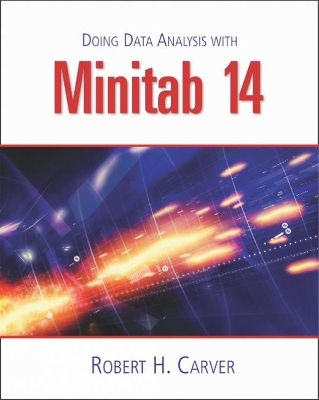
Doing Data Analysis with MINITAB' 14 (with CD-ROM)
Brooks/Cole
978-0-534-42084-0 (ISBN)
- Titel ist leider vergriffen;
keine Neuauflage - Artikel merken
This text provides clearly written and comprehensive tutorials that allow introductory students of statistics to learn how to use MINITAB(TM) software to their full advantage. The book's tutorials and exercises demonstrate MINITAB as a way to understand statistical concepts and practice statistical reasoning. All datasets are real and reflect a variety of subject areas, including business, social sciences, physical sciences, life sciences, humanities, engineering, and general interest.
Robert Carver is Professor of Business Administration at Stonehill College in Easton, Massachusetts. He teaches courses in business statistics, information systems, business and society, as well as the Department's Senior Honors Research Seminar. He is author of two statistics texts for Duxbury Press, and his research has appeared in THE JOURNAL OF STATISTICS EDUCATION, THE JOURNAL OF BUSINESS ETHICS, THE JOURNAL OF CONSUMER MARKETING, THE PUBLIC PRODUCTIVITY REVIEW, PS: POLITICAL SCIENCE AND POLITICS, PUBLIUS, and THE PUBLIC ADMINISTRATION REVIEW. He earned his A.B. from Amherst College and his M.P.P. and Ph.D. from the University of Michigan.
Typographical Conventions. 1. A FIRST LOOK AT MINITAB. Objectives. Launching MINITAB. Entering Data into a Worksheet. Saving a Worksheet. Creating a Chart. Saving a Project. Getting Help. Printing in MINITAB. Quitting MINITAB. 2. TABLES AND GRAPHS FOR ONE VARIABLE. Objectives. Opening a Worksheet. A Dotplot. Exploring the Data with Stem-and-Leaf. Creating a Histogram. Frequency Distributions with Tally. Printing Session Output. Another Bar Chart. Moving On... 3. TABLES AND GRAPHS FOR TWO VARIABLES. Objectives. Cross-Tabulating Data. Editing Your Most Recent Dialog. More on Bar Charts. Comparing Two Distributions. Scatterplots to Detect Relationships. Moving On... 4. ONE-VARIABLE DESCRIPTIVE STATISTICS. Objectives. Computing One Summary Measure for a Variable. Computing Several Summary Measures. Generating a Box-and-Whiskers Plot. Standardizing a Variable. Moving On... 5. TWO-VARIABLE DESCRIPTIVE STATISTICS. Objectives. Comparing Dispersion with the Coefficient of Variation. Descriptive Measures for Subsamples. Measures of Association: Covariance and Correlation. Moving On... 6. ELEMENTARY PROBABILITY. Objectives. Simulation. A Classical Example. Observed Relative Frequency as Probability. Handling Alphanumeric Data. Moving On... 7. DISCRETE PROBABILITY DISTRIBUTIONS. Objectives. An Empirical Discrete Distribution. Graphing a Distribution. Transferring Session Output to the Worksheet. Computing the Expected Value of a Theoretical Distribution: The Binomial. Another Theoretical Distribution: The Poisson. Moving On... 8. PROBABILITY DENSITY FUNCTIONS. Objectives. Continuous Random Variables. Generating Normal Distributions. Finding Areas under a Normal Curve. Normal Curves as Models. Moving On... 9. SAMPLING DISTRIBUTIONS. Objectives. What is a Sampling Distribution? Sampling from a Normal Population. Central Limit Theorem. Sampling Distribution of the Proportion. Moving On... 10. CONFIDENCE INTERVALS. Objectives. The Concept of a Confidence Interval. Effect of Confidence Coefficient. Large Samples from a Non-normal (Known) Population. Dealing with Real Data. Small Samples from a Normal Population. Confidence Interval for a Population Proportion. Moving On... 11. ONE-SAMPLE HYPOTHESIS TESTS. Objectives. The Logic of Hypothesis Testing. An Artificial Example. A More Realistic Case: We Don"t Know Sigma. A Small-Sample Example. A Test Involving Proportion. Moving On... 12. TWO-SAMPLE HYPOTHESIS. Objectives. Working with Two Samples. Matched vs. Independent Samples. Comparing Two Proportions. Moving On... 13. CHI-SQUARE TESTS. Objectives. Review of Qualitative vs. Quantitative Data. Goodness-of-Fit Testing. A First Example: Simple Genetics. Testing for Independence. Testing for Independence (Summary Data Only). Moving On... 14. ANALYSIS OF VARIANCE. Objectives. Comparing the Means of More than Two Samples. A Simple Example. ANOVA and the Two-Sample t-Tests. Another Example. Unstacked Data. A Two-Way ANOVA. Moving On... 15. LINEAR REGRESSION (I). Objectives. Linear Relationships. Another Example. Inference from Output. An Example of a Questionable Relationship. An Estimation Application. A Classic Example. Moving On... 16. LINEAR REGRESSION (II). Objectives. Assumptions for Least Squares Regression. Examining Residuals to Check Assumptions. A Time-Series Example. Issues in Forecasting and Prediction. A Caveat about "Mindless" Regression. Moving On... 17. MULTIPLE REGRESSION. Objectives. Going Beyond a Single Explanatory Variable. Significance Testing and Goodness of Fit. Prediction and Residual Analysis. Adding More Variables. A New Concern. Another Example. Working with Qualitative Variables. Moving On... 18. NON-LINEAR MODELS. Objectives. When Relationships Are Not Linear. A Simple Example. Some Common Transformations. Another Quadratic Model. A Logarithmic Transformation. Adding More Variables. Moving On... 19. BASIC FORECASTING TECHNIQUES. Objectives. Detecting Patterns over Time. Some Illustrative Examples. Forecasting Using Moving Averages. Forecasting Using Exponential Smoothing. Forecasting Using Trend Analysis. Moving On... 20. NONPARAMETRIC TESTS. Objectives. Nonparametric Methods. A Sign Test. A Wilcoxon Signed Rank Test. Mann-Whitney U Test. Kruskal-Wallis Test. Spearman Rank Order Correlation. A Runs Test. Moving On... 21. STATISTICAL PROCESS CONTROL. Objectives. Processes and Variation. Charting a Process Mean. Charting a Process Range. Another Example. Charting a Process Proportion. Moving On... Appendix A: Dataset Descriptions. Appendix B: Working with Files. Objectives. Worksheets. Session and History Files. Graph Files. MINITAB Projects. Converting Other Data Files into MINITAB Worksheets. Appendix C: Organizing a Worksheet. Choices. Stacked Data. Unstacked Data. Summarized Data. Appendix D: Working with Other Minitab Releases. Objectives. Differences Between Release 14 and Earlier Versions. Issues for Student Version 14 Users. Summary of Sessions Where Differences Arise. Workarounds for Earlier Releases. Commands Without Equivalents in Earlier Releases. Index.
| Erscheint lt. Verlag | 1.8.2003 |
|---|---|
| Zusatzinfo | ill |
| Verlagsort | CA |
| Sprache | englisch |
| Themenwelt | Mathematik / Informatik ► Mathematik ► Computerprogramme / Computeralgebra |
| ISBN-10 | 0-534-42084-2 / 0534420842 |
| ISBN-13 | 978-0-534-42084-0 / 9780534420840 |
| Zustand | Neuware |
| Informationen gemäß Produktsicherheitsverordnung (GPSR) | |
| Haben Sie eine Frage zum Produkt? |